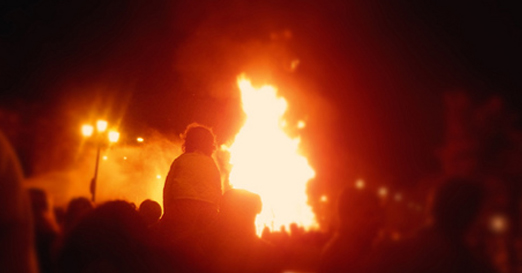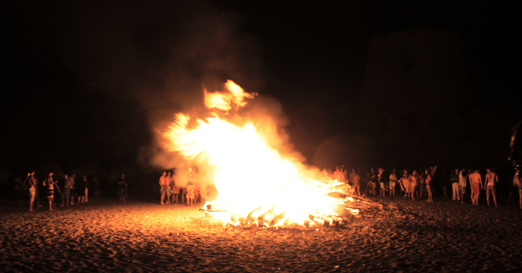NOCHE DE SAN JUAN

The Bonfires of San Juan originate in the tradition of burning useless objects with the arrival of the summer solstice. It is considered the major festival of the city of Alicante, having been declared of International Tourist Interest.
During this festival you can see more than two hundred authentic cardboard sculptures (bonfires) scattered on the streets of the city representing various satirical themes. They are burnt down 24th June in the spectacular night of “Cremà", accompanied by the popular “banyá“ (bath) conducted by the firefighters, who extinguish the bonfire flames. During the holidays, we can also see parades and processions such as: the “Mascletàs“, the “Pregón”, “Plantà” or "Cabalgata del Ninot” , with the most important one being “The Offering of Flowers to The Virgen del Remedio”.
HISTORY
This festival dates back to the time when the farmers in Alicante celebrated the longest day of the year for harvesting crops and the shortest night dedicated to the destruction of evil (the actual shortest night of the year is between the 20th and 21st of June). This tradition soon spread to the city of Alicante, in response to which the mayor made a public announcement stating:
“...no bonfires are to be lit in the streets, and no fire shots and fireworks are to be heard the night of San Juan or fines of 20-100 Real will be received as a consequence.”
But in 1881 the council neglected to publish the usual announcement and the residents of Alicante took advantage of this circumstance to group by "street parties" establishing games and creating the first "ninots" – cardboard figures in the shape of known characters, that were criticized. In 1928 the first official holiday of the city of Alicante started with the figure of José María Py, main promoter of the Bonfires, and his speech:
“The bonfires of Alicante are a well known tradition since ancient times and we should give it the same importance that has been given to the Fallas of Valencia.”

This idea, that aimed to attract tourists just as in Valencia, made possible the birth of the first Bonfires of San Juan, permitted by the City Council that same year. From 1932, the commission created the ultimate representation of this event, "The Beauty of Fire" (Bellea del foc), maximum importance for each committee, which is elected annually.
The last fire festivals in the period of the Spanish Civil War were held in 1936 and some attempts to keep the tradition alive were made around 1939. In 1940 the habit became permanent again.
CELEBRATION
The Bonfires of San Juan are considered the public holidays of the city of Alicante (Spain) and are declared of International Tourist Interest. Its origins are vague but it is in 1928 when the festival acquires its current characteristics.
José María Py was considered the festival’s greatest promoter at that time. Originally from Cadiz, he moved to Alicante and oficialized the festival in the style of the Valencian one, after having lived in the latter of the cities for twenty five years.
The festivities begin with the proclamation, which takes place the Friday before the “plantà”. From the 17th to the 20th of June, “hogueras" figures start to be prepared in the form of artistic monuments of painted wood, cardboard or cork, containing a certain satirical connotation. Each bonfire represents a street, zone or neighborhood of the city. Four days later each figure gets burned after a monumental firework display, visible from almost any point of the city, is launch from the top of the Benacantil Mountain, where the Castle of Santa Barbara towers over the city.
During the festival, there is an extensive program of activities with cavalcades, parades and processions or ” despertàs”, bullfights, mascletaes, musical performances, sports competitions and more. The celebration brings the streets to life all throughout the day and night, and people can eat and dance in the “Barracks” and “Racós” or sample traditional food such as the “coca amb tonyina” or the “bacore”. The festivity has its queen, Foc Bellea, chosen from the "beauties" of each of the 91 participating districts.
The Alicante Bonfires are lit on the night of June 24, San Juan's eve, (unlike other places in Spain where traditional bonfire burning occurs in the evening of June 23). Due to the heat of the time of year, and the increase because of the fire, it is common practice for the firefighters that control the evolution of the bonfire to freshen up the people that so request it, a habit that came to be known as “Banyá" – the showering.



